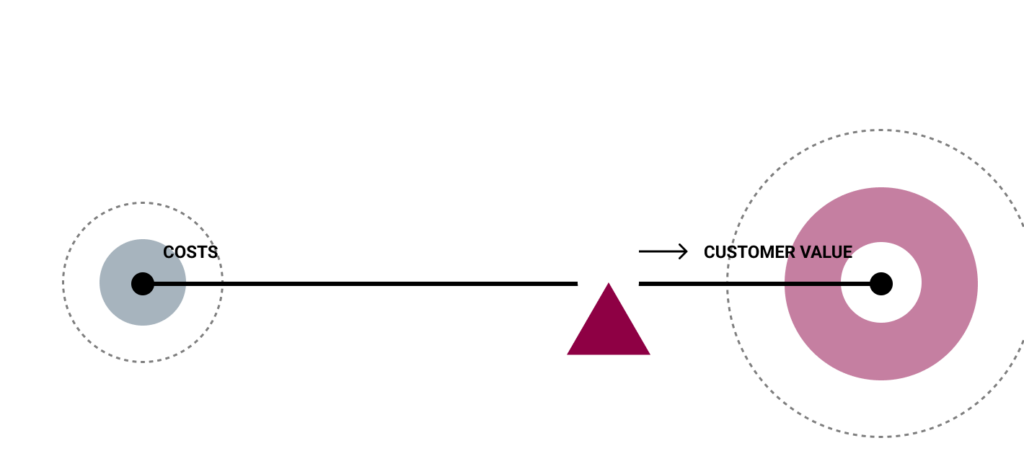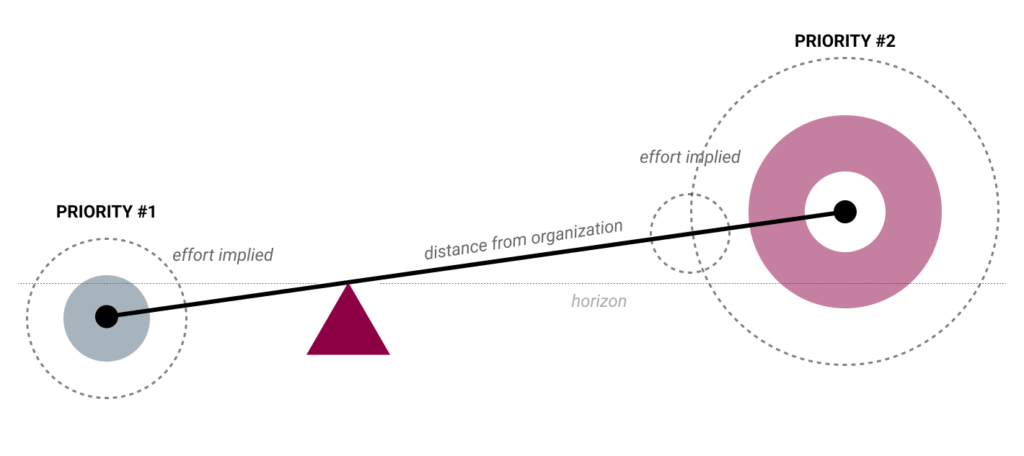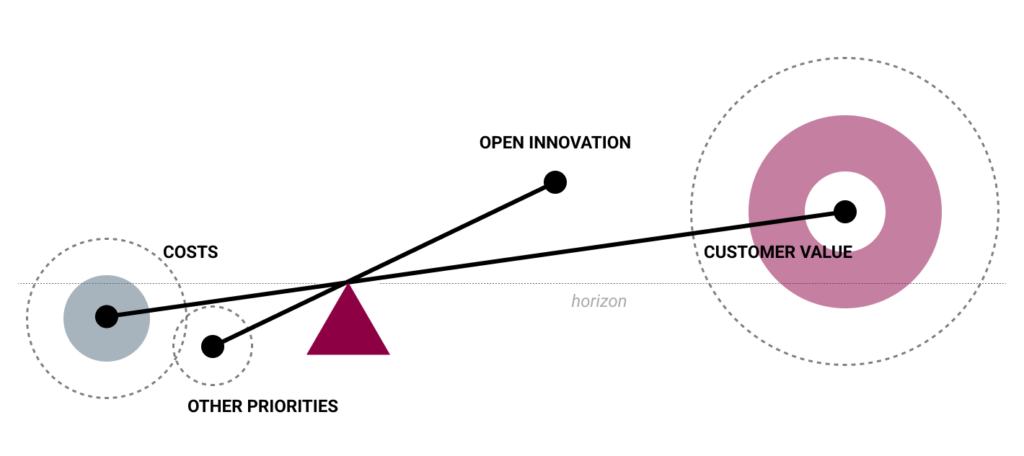Distance Scale

The Distance Scale is a tool to visualize the distance between driving forces inside your organization.
WHAT IS IT
The Distance Scale is a decision-making model that helps companies to prioritize their business strategies by assessing the weight of driving forces within a specific context. The model uses the metaphor of distances and levers to help C-level and D-level executives evaluate the relative importance of different factors and make informed decisions.
At the most basic level, the Distance Scale model suggests that the farther away a driving force is from the point of decision, the less influence it has. This is because distant driving forces are less immediate and less tangible, and therefore have less impact on the decision at hand. On the other hand, driving forces that are closer to the point of decision are more immediate and more tangible, and therefore have a greater influence on the decision.
The lever aspect of the Distance Scale model refers to the amount of influence that a driving force has on the decision. A driving force with a large lever is more influential than one with a small lever. For example, a driving force such as “increasing profits” might have a large lever because it is a key priority for the company, while a driving force such as “improving employee morale” might have a smaller lever because it is less directly related to the company’s bottom line.
By using the Distance Scale model, companies can more effectively prioritize their business strategies and make informed decisions. The model helps executives to weigh the relative importance of different driving forces and allocate resources accordingly. This can lead to more effective and efficient decision-making, ultimately helping the company to achieve its goals and objectives.

The more the items you are evaluating on the same axis are in direct opposition, the better the lever works.
Take “cost reduction” and “customer value“, you can’t genuinely maximize them both without compromises. Furthermore, the fulcrum is positioned at the center for a simplification purpose, but by taking the metaphor to a higher level, while the arms represented an assessment of your current organizational context, the fulcrum positioning is a deliberate choice.

Quick Tip: Since the Fulcrum positioning works in a counterintuitive way (not all people have basic physics knowledge), always highlight the resulting arm length as a sign of strategic commitment.
Increase the Distance

Increase the Weight


WHY IT IS RELEVANT
The use of a Distance Scale is optimal for complex organizations because it helps to simplify and clarify the decision-making process. In a complex organization, there may be many different driving forces at play, each with its own set of priorities and goals. The Distance Scale model allows executives to clearly assess the relative importance of these driving forces and make informed decisions based on this assessment.
One key pitfall that the Distance Scale model can help to avoid is the tendency to prioritize short-term goals over long-term ones. In the business world, it is often tempting to prioritize immediate gains over long-term planning and strategy. The Distance Scale model helps to counter this tendency by allowing executives to consider the relative distance and lever of different driving forces, taking into account both short-term and long-term priorities.
Another pitfall that the Distance Scale model can help to avoid is the tendency to prioritize individual goals over collective ones. In a complex organization, it is important to consider the impact of decisions on all stakeholders, including employees, customers, and shareholders. The Distance Scale model helps executives to take a holistic view of decision-making, considering the relative importance of different driving forces in the context of the organization as a whole.

USE IT FOR
A Distance Scale should be used in any scenario where a complex organization needs to make a decision and prioritize its goals and objectives. The model is particularly useful when there are multiple driving forces at play, each with its own set of priorities and goals.
Some practical scenarios in which a Distance Scale might be used include:
- Developing a new product or service: When launching a new product or service, there are often many different factors to consider, such as market demand, production costs, and competition. The Distance Scale model can help executives to prioritize these factors and make informed decisions about how to allocate resources.
- Allocating resources: In a complex organization, there are often limited resources available to support different initiatives. The Distance Scale model can help executives to prioritize which initiatives should receive the most resources based on their relative distance and lever.
- Making strategic decisions: When making strategic decisions, it is important to consider the long-term implications of different options. The Distance Scale model helps executives to weigh the relative importance of different driving forces and make informed decisions that align with the organization’s long-term goals and objectives.
REQUIREMENTS
-
Key People
Gather key people accountable for deciding the vision according to the scope. C-Levels are required to decide values that will set the course of the organization for the next strategic plan, D-Levels and Managers are required if the scope level is bound to a business line, Managers and Produt Owners if values refer to a product.
-
A Workshop Space
To define Core Values, a workshop or a brainstorming session works best. Be sure to have a large table or a big wall as a working canvas to work respectvely with cards or post-its.
-
External Data and POVs
Bring at the discussion external points of view from outside your organization, such as competitor analysis, survey, and other researches. External data can be used to inpire, inform or even challenge internal belief and avoid hindsights.
STEP BY STEP
-
Identify the Driving Forces
The first step in compiling a Distance Scale is to identify the key driving forces that are at play in the decision-making process. These may include factors such as market demand, competition, production costs, and long-term goals.
-
Assess the distance and lever of each driving force
Next, evaluate the relative distance and lever of each driving force. The distance of a driving force refers to its proximity to the point of decision, with distant driving forces having less influence and closer driving forces having more influence. The lever of a driving force refers to its relative importance or influence on the decision.
-
Rank the driving forces
Based on the distance and lever of each driving force, rank them in order of importance. This will help to prioritize the driving forces and inform the decision-making process.
-
Consider the interdependence of driving forces
As you compile the Distance Scale, keep in mind that driving forces may be interdependent, meaning that they have an impact on one another. For example, a driving force such as "increasing profits" may have a larger lever if it is closely linked to other driving forces such as "improving customer satisfaction" or "reducing costs."
-
Use the Distance Scale to inform decision-making
Once you have compiled the Distance Scale, use it to inform your decision-making process. Prioritize the driving forces that have the highest distance and lever, and consider how they will impact the decision at hand.




